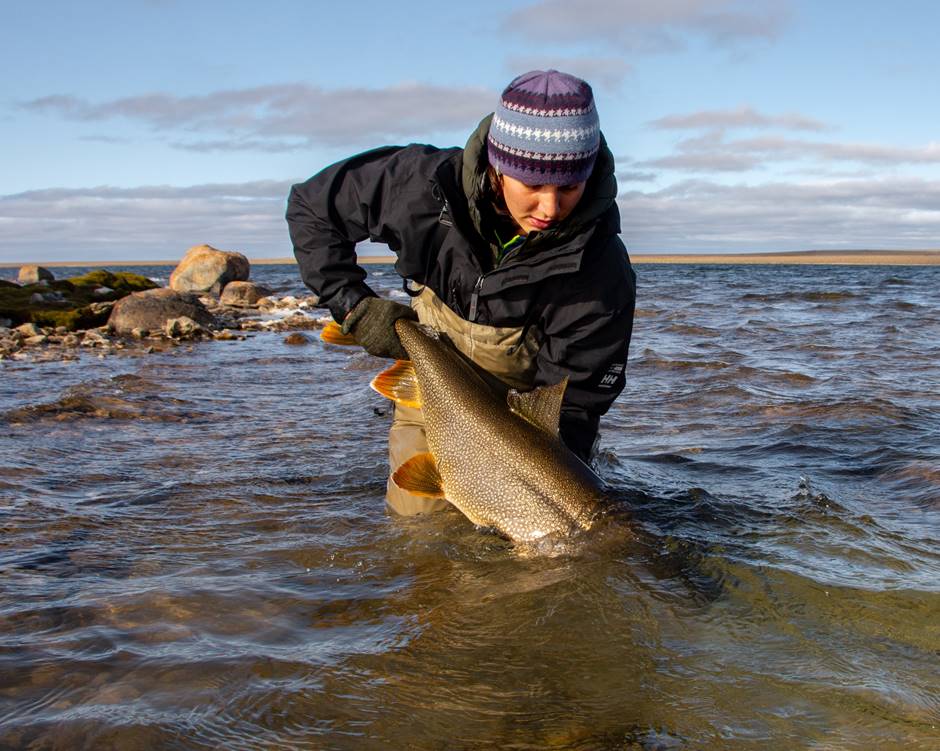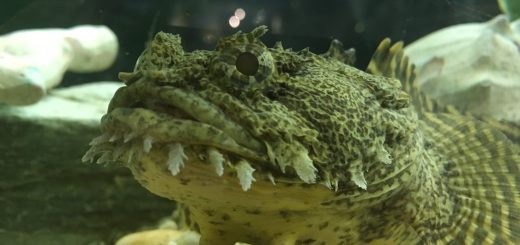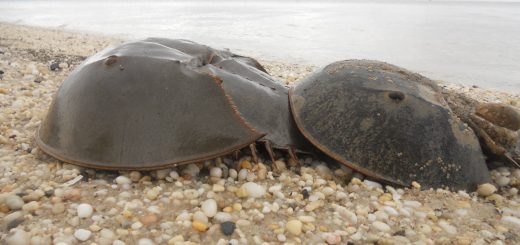How Lake Trout Use Ocean Habitat
Fishes like shad and salmon are well known for large annual migrations between rivers and oceans. This life history trait, known as anadromy, allows fish to take advantage of the perks of both habitats. Rivers and streams offer refuge from predators, whereas the ocean offers an abundance of food. Anadromy can also be found on a smaller scale, as is seen in the northern chars belonging to the genus Salvelinus. These populations often include some individuals that migrate to sea and some that don’t. Having these multiple strategies within a population increases the chances that some fish will survive sudden changes in environmental conditions. In northern areas where the growing season is short, freshwater habitat is not as productive as marine habitat (Gross et al. 1988). Here, anadromous fish migrate to the ocean to take advantage of the food available in this habitat.

For a long time, scientists thought that one species of northern char, the lake trout (Salvelinus namaycush), did not move between freshwater and marine habitats. Lake trout generally have a difficult time maintaining the balance between water and salt within their bodies when placed in saltwater (Hiroi and McCormick 2007), but there have been cases where this species was seen in the ocean (e.g., Swanson et al. 2010). This led to the question of whether lake trout were straying into the ocean occasionally or if some individuals used marine habitat as part of an annual migration. To address this, Les Harris (Fisheries and Oceans Canada) and colleagues conducted a two-part study that took place in the central Arctic region of Canada (Harris et al. 2020). First, these scientists collected otoliths (or ear bones) from 10 lake trout caught in four different rivers. As fish age, new layers are added to otoliths like the rings of a tree. Otoliths store elements like strontium at the same concentration as what is seen in the local environment, and can be used to determine if a fish has moved between marine and freshwater habitat throughout its lifetime because seawater has a higher concentration of strontium than freshwater. By measuring strontium in the lake trout otoliths, the scientists found that adult fish first migrated to the ocean at different ages (16-45 years) and there was a wide range in how often they used marine habitat throughout their lifetimes. Some of the fish only migrated to the ocean once, others up to nine times.

Next, Harris and colleagues caught 5 fish at the mouth of the Ekalluk River (in Canada’s Nunavut territory) and tagged them with acoustic tags. Fish were tracked as they moved between freshwater and marine habitats, and the scientists were able to develop a more detailed picture of the marine habitat lake trout prefer. Tagged lake trout spent most of their time in estuaries and preferred to occupy the top layer of water which was fresher and warmer rather than moving further and deeper into the ocean. Occasionally, individuals would dive to deeper waters or move a little further out to sea, but these were short trips after which fish returned to their preferred estuarine and surface-water habitat. This is in stark contrast to their usual habits in lakes of occupying deep, cold water.

Results from both parts of the study indicated that some lake trout do migrate between freshwater and estuaries for multiple years throughout their lifetime, but there is a wide range among individuals in how many times this occurs. In addition, the lake trout in this study seemed to prefer warmer habitat that had lower salinity, which follows that this species is not as adept at maintaining its salt and water balance as well as other salmonids. Harris and colleagues concluded that individuals within populations of lake trout in Canada’s central Arctic have adapted to take advantage of productive estuary habitat. Utilizing marine habitat allows fish to grow at a faster rate and to a larger size, which can lead to a reproductive advantage (McDowall 2001). Unfortunately, this comes at the cost of greater energy use during migration and the danger of dying at sea. Such a tradeoff could explain why not all individuals within a lake trout population are anadromous. This study is the first to explore how populations of lake trout use marine habitat, and hopefully the anadromous strategy used by this species will continue to be studied.
References:
Gross MR, Coleman RM, and McDowall RM. 1988. Aquatic productivity and the evolution of diadromous fish migration. Science. 239: 1291-1293.
Hiroi J and McCormick SD. 2007. Variation in salinity tolerance, gill Na+/K+-ATPase, Na+/K+/2Cl- cotransporter and mitochondria-rich cell distribution in three salmonids Salvelinus namaycush, Salvelinus fontinalis and Salmo salar. Journal of Experimental Biology. 210: 1015-1024.
Swanson HK, Kidd KA, Babaluk JA, Wastle RJ, Yang PP, Halden NM, and Reist JD. 2010. Anadromy in Arctic population sof lake trout (Salvelinus namaycush): Otolith microchemistry, stable isotopes, and comparisons with Arctic char (Salvelinus alpinus). Canadian Journal of Fisheries and Aquatic Sciences. 67: 842-853.
Harris LN, Swanson HK, Gilbert MJH, Malley BK, Fisk AT, and Moore JS. 2020. Anadromy and marine habitat use of Lake trout (Salvelinus namaycush) from the central Canadian Arctic. Journal of Fish Biology. Early view. https://doi.org/10.1111/jfb.14305
McDowall RM. 2001. Anadromy and homing: two life-history traits with adaptive synergies in salmonid fishes? Fish and Fisheries. 2: 78-85.
Photo credits: B. Malley and JS Moore.



